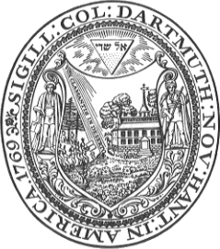Seal of Dartmouth College
The Seal of Dartmouth College is the official insignia of Dartmouth College, an Ivy League university located in Hanover, New Hampshire, United States. Anglo-American law generally requires a corporate body to seek official government sanction, usually in the form of a charter, in order to operate. Such chartered bodies normally authenticate their official acts by marking them with a distinctive seal. The seal's design is usually complicated to avoid counterfeiting, but it can also express something about the institution's history or mission. Dartmouth College is one such chartered body, and it obtained its official seal in 1773.

Design and creation
Dartmouth College received a royal charter on December 13, 1769 through New Hampshire's colonial governor John Wentworth. The charter required a seal that was to be:
engraven in such a form and with such an inscription as shall be devised by the said Trustees for the time being or by the major part of any seven or more of them convened for the service of the said College as is above directed.[1]
Nevertheless, on March 13, 1770, founder Eleazar Wheelock wrote to the trustees of the English fund that was supporting the College (rather than the American trustees of the institution itself, as the charter stipulated) to suggest that his:
Patrons would devise a proper Seal for the College with one of the Gentlemans coat of arms upon it, if they shall think Proper this motto around it Vox Clamantis in Deserto this may also Serve a proper Seal for the Commissions of the Missionaries, as well for Diplomas, and be a Standing Evidence and monitor to succeeding Generations of the Original Design of this Institution.[2]
The English trustees, including Lord Dartmouth, did not take up the suggestion. Evidence exists that they were annoyed with Wheelock's acquisition of a charter for a college; they were under the impression that the funds under their control were to be used to support Wheelock's efforts at educating and Christianizing Native Americans at Moor's Indian Charity School at Lebanon, Connecticut.[3] Wheelock then designed a seal for his college bearing a striking resemblance to the seal of the Society for the Propagation of the Gospel, a missionary society founded in London in 1701, in order to maintain the illusion that his college was more for mission work than for higher education. Wheelock arranged for Nathaniel Hurd, a Boston silversmith, to engrave the seal. Hurd had engraved many coats of arms and appears in a John Singleton Copley portrait of ca. 1765 with two books, one of which is A Display of Heraldry by John Guillim (1610).[4] Wheelock wrote to Governor Wentworth on May 22, 1772, saying "I hope that Mr Hurd will have the College Seal compleated by Commencement."[5] The seal (a single-sided "female" die used to form impressions in wax) was ready by Commencement of 1773, and Portsmouth resident and former Chief Justice and Treasurer of the Province of New Hampshire George Jaffrey donated it to the College. The trustees officially accepted the seal on August 25, 1773, describing it as:
An Oval, circumscribed by a Line containing SIGILL: COL: DARTMUTH: NOV: HANT: IN AMERICA 1770. within projecting a Pine Grove on the Right, whence proceed Natives towards an Edifice two Storey on the left; which bears in a Label over the Grove these Words "vox clamantis in deserto" the whole supported by Religion on the Right and Justice on the Left, and bearing in a Triangle irradiate, with the Hebrew Words [El Shaddai], agreeable to the above Impression, be the common Seal under which to pass all Diplomas or Certificates of Degrees, and all other Affairs of Business of and concerning Dartmouth College.[6]
History and revisions
Former College Librarian William Woodward hid the seal from Dartmouth's officers along with the charter and four account books after the state of New Hampshire purported to take over the operation of Dartmouth College (and purported to make Woodward Treasurer of Dartmouth University). The Dartmouth College Case named Woodward as the defendant and technically sought to recover the items that he had hidden.[7] The College's success in the Supreme Court returned the seal to its possession and extinguished the University.
In 1876, the College switched from having its seal impress wax to having it impress paper. This required a second, "male" die to fit under the original.[3] The seal design was also carved in sandstone on the exterior of Rollins Chapel in 1886 (see above) and in wood on the interior of Commons in the Collis Center in 1901 (see right).
On October 28, 1926, the trustees affirmed the charter's reservation of the seal for official corporate documents alone.[3] The College Publications Committee under Ray Nash commissioned typographer W. A. Dwiggins to create a line-drawing version of the seal in 1940 that saw widespread use.
Dwiggins' design was modified during 1957 to change the date from "1770" to "1769," to accord with the date of the College Charter. The trustees commissioned a new set of dies with a date of "1769" to replace the old dies, now badly worn after almost two hundred years of use.[3] The 1957 design continues to be used under trademark number 2305032.[8]
Notes
- "The Charter of Dartmouth College". Dartmo.: The Buildings of Dartmouth College. Retrieved 2007-09-25.
- Dartmouth College Library, Special Collections MS 770213.2.
- Good, Jonathan (April 1997). "Notes from the Special Collections: The Dartmouth College Seal". Dartmouth College Library Bulletin. Dartmouth College Library. Retrieved 2007-09-25.
- Coppley, John Singleton (c. 1765). "Portrait of Nathaniel Hurd". Cleveland Museum of Art. Archived from the original on June 26, 2006. Retrieved 2007-09-25.
- Hoefnagel, Dick; Virginia L. Close (November 1995). "Journey to Hanover, 1771". Dartmouth College Library Bulletin. Dartmouth College Library. Retrieved 2007-09-25.
- Dartmouth College, Trustees' Records, 1:26. Dartmouth College Library, Special Collections, DA-1.
- "Trustees of Dartmouth College vs. Woodward". 17 U.S. 518. Cornell Law School Legal Information Institute. 1819. Retrieved 2007-09-25.
- "United States Patent and Trademark Office". Retrieved 2007-09-25.
